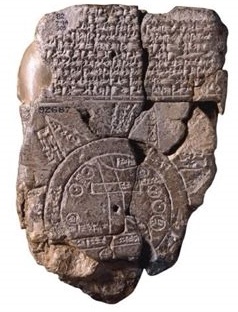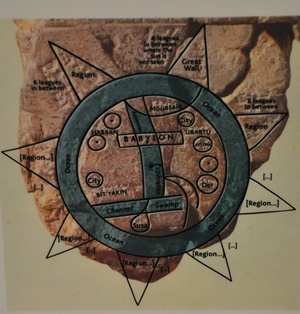Print Article
Author's Bias | Interpretation: conservative | Inclination: promise | Seminary: none

A Babylonian map of the world
The Mesopotamian Chronicles is a broad category for a large number of Assyrian and Babylonian cuneiform
texts that record the significant historical events of ancient Mesopotamia. The list of texts and fragments
is extensive.
The cuneiform script is either Sumerian, Akkadian or Babylonian.
The inscriptions, whether they are on plaques, cylinders, etc. are catalogued in three
main reference works. Within each work, the original text of the inscription can be found with their English
translation.
Grayson AK, Assyrian and Babylonian Chronicles, University Park: Eisenbrauns (2000).
Glassner JJ, Chroniques Mésopotamiennes, Paris: Les Belles Lettres (1993), translated
and edited by Foster BR, Mesopotamian Chronicles, Atlanta: Society of Biblical Literature (2004).
Finkel I, Van der Spek RJ, Babylonian Chronicles of the Hellenistic Period (not yet
published).
Of the Mesopotamian Chronicles, the records that cover the approximate time of 700-539 B.C. are known as the
Babylonian Chronicles. Considered the most reliable of ancient official records, these texts are largely about
the Neo-Babylonian empire, which are of great interest to biblical scholars for its historical involvement with
the Kingdom of Judah.
Grayson’s book, Assyrian and Babylonian Chronicles, was the first to publish all of the Mesopotamian
texts of the time (1975) where each text was accompanied with its transliteration, translation, and commentary.
The work became a standard and scholars refer to various texts by their listing in Assyrian and Babylonian
Chronicles (ABC) as ABC1, ABC2, etc. The Babylonian Chronicles refer to 6 principal records:

How the Babylonian map was understood
ABC1: The Chronicle on the Reigns from Nabû-Nasir to Šamaš-šuma-ukin
This chronicle records the resistance of an increasingly stronger Babylon, supported by Elam,
against Assyria, beginning with the reign of the Babylonian king Nabû-Nasir (747-734) and culminating in the
accessions of Aššurbanipal in Assyria and Šamaš-šuma-ukin in Babylonia in 668 B.C.
The text is preserved on two copies that are now in the British Museum; one of these copies
was written in 499 B.C., the twenty-second year of king Darius I the Great. (It is the only Neo-Babylonian
chronicle that is preserved on more than one copy.) The other fragments are from Sippar. (1)
ABC3: Fall of Ninevah Chronicle (Nabolassar / Gadd Chronicle)
The Fall of Ninevah / Gadd Chronicle records Nabopolassar's capture of Nineveh, the capital
of Assyria, one of the most shocking events in ancient history. This chronicle belongs to one large text that
started with the Early Years of Nabopolassar (ABC 2) and continued with the Fall of Nineveh and the Late Years
of Nabopolassar (ABC 4). (2)
ABC5: Nebuchadnezzar Chronicle (Jerusalem Chronicle)
The Nebuchadnezzar Chronicle speaks to several subjects, but the reference to the capture
of Jerusalem in 597 B.C. has attracted most attention, which explains the name "Jerusalem Chronicle". Among
scholars, it is known better as the Chronicle Concerning the Early Years of Nebuchadnezzar II (ABC 5) and is
studied for its record about Nebuchadnezzar's accession to the throne, his campaigns against the Egyptian king
Necho II, an Elamite intervention, and a revolt in Babylonia itself. The chronicle starts where ABC 4 ends:
during the wars after the sack of Nineveh in 612 and the collapse of the Assyria Empire. (3)
ABC7: Nabonidus Chronicle
The Chronicle Concerning the Reign of Nabonidus (ABC 7) is one of the most important
historiographical texts from ancient Babylonia. It deals not just with the reign of Nabonidus (r.556-539 B.C.),
but also with the rise of the Persian king Cyrus the Great, the demise of the Babylonian Empire, and the
founding of the Achaemenid Empire. (4)
ABC14: Esarhaddon Chronicle
This chronicle records the wars of king Esarhaddon (680-669) and the accessions of his sons
Aššurbanipal in Assyria and Šamaš-šuma-ukin in Babylonia. (5)
ABC16: Akitu Chronicle
The Akitu Chronical deals with the war between the Babylonian king Šamaš-šuma-ukin and his
brother Aššurbanipal, king of Assyria. Its name is derived from the fact that the author shows a special interest
in the celebration of the Akitu festival. (6)
References:
1. From the website: Livius.org, "ABC 1 (From Nabû-Nasir to Šamaš-šuma-ukin)."
2. From the website: Livius.org, "ABC 3 (Fall of Nineveh Chronicle)."
3. From the website: Livius.org, "ABC 5 (Jerusalem Chronicle)."
4. From the website: Livius.org, "ABC 7 (Nabonidus Chronicle)."
5. From the website: Livius.org, "ABC 14 (Esarhaddon Chronicle)."
6. From the website: Livius.org, "ABC 16 (Akitu Chronicle)."
Copyright ©
2018
Helpmewithbiblestudy.org. All rights to this material are reserved. We encourage you to print the material for personal and
non-profit use or link to this site. If you find this article to be a blessing, please share the link so that it may rise in
search engine rankings.